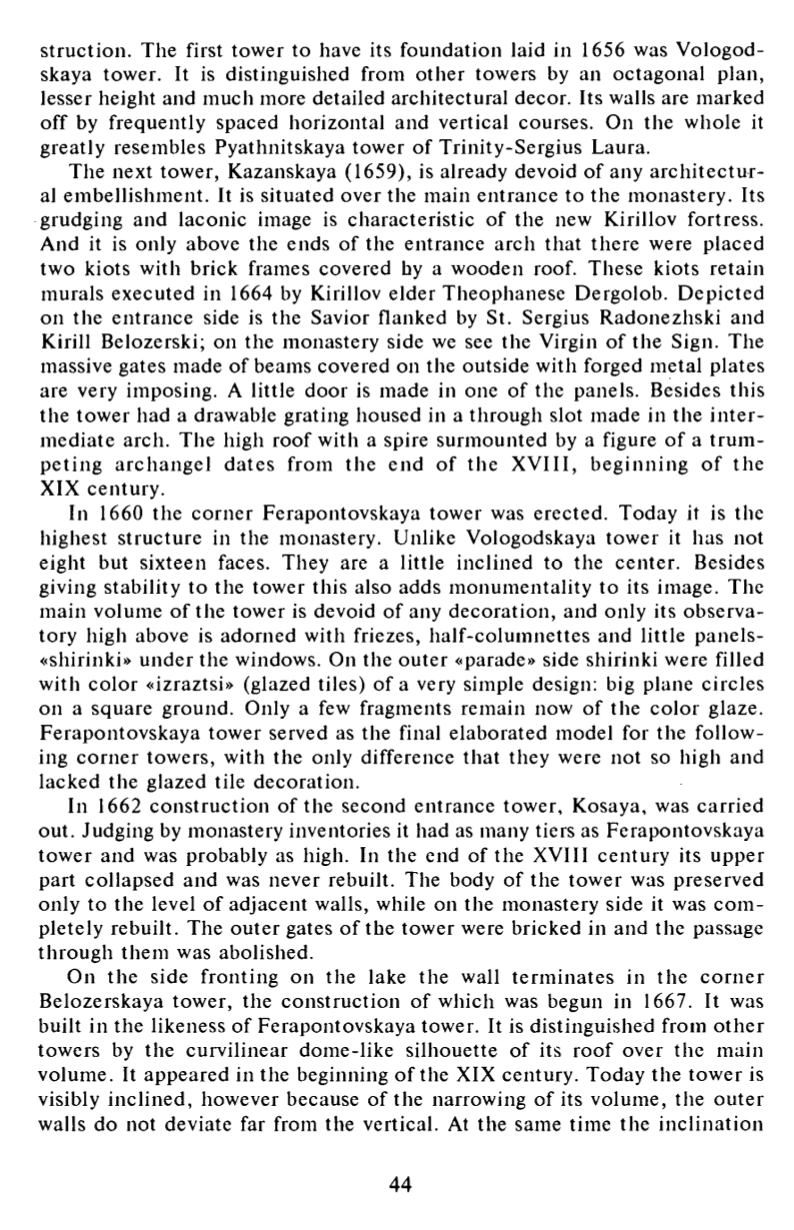

struction. The first tower to have its foundation laid in 1656 was Vologod-
skaya tower. It is distinguished from other towers by an octagonal plan,
lesser height and much more detailed architectural decor. Its walls are marked
off by frequently spaced horizontal and vertical courses. On the whole it
greatly resembles Pyathnitskaya tower of Trinity-Sergius Laura.
The next tower, Kazanskaya (1659), is already devoid of any a rch ite c tu r
al embellishment. It is situated over the main entrance to the monastery. Its
grudging and laconic image is characteristic of the new Kirillov fortress.
And it is only above the ends of the entrance arch that there were placed
two kiots with brick frames covered by a wooden roof. These kiots retain
murals executed in 1664 by Kirillov elder Theophanese Dergolob. Depicted
on the en trance side is the Savior flanked by St. Sergius Radonezhski and
Kirill Belozerski; on the monastery side we see the Virgin of the Sign. The
massive gates made of beams covered on the outside with forged metal plates
are very imposing. A little door is made in one of the panels. Besides this
the tower had a drawable grating housed in a through slot made in the in te r
mediate arch. The high roof with a spire surmounted by a figure o f a t rum
pe ting a rchange l dates from the end o f the XVIII, beg inn ing o f the
XIX century.
In 1660 the corner Ferapontovskaya tower was erected. Today it is the
highest structure in the monastery. Unlike Vologodskaya tower it has not
eight but sixteen faces. They are a little inclined to the center. Besides
giving stability to the tower this also adds monumentality to its image. The
main volume o f the tower is devoid of any decoration, and only its observa
tory high above is adorned with friezes, half-columnettes and little panels-
«shirinki» under the windows. On the outer «parade» side shirinki were filled
with color «izraztsi» (glazed tiles) of a very simple design: big plane circles
on a square ground. Only a few fragments remain now of the color glaze.
Ferapontovskaya tower served as the final elaborated model for the follow
ing co rne r towers, with the only difference that they were not so high and
lacked the glazed tile decoration.
In 1662 construction of the second entrance tower, Kosaya, was carried
out. Judging by monastery inventories it had as many tiers as Ferapontovskaya
tower and was probably as high. In the end of the XVIII century its upper
part collapsed and was never rebuilt. The body of the tower was preserved
only to the level o f adjacent walls, while on the monastery side it was c om
pletely rebuilt. The outer gates o f the tower were bricked in and the passage
th rough them was abolished.
On the side fronting on the lake the wall term ina te s in the co rn e r
Belozerskaya tower, the construction of which was begun in 1667. It was
built in the likeness of Ferapontovskaya tower. It is distinguished from o ther
towers by the curvilinear dome-like silhouette of its roof over tlie main
volume. It appeared in the beginning o f the XIX century. Today the tower is
visibly inclined, however because of the narrowing of its volume, the outer
walls do not deviate far from the vertical. At the same time the inclination
44















